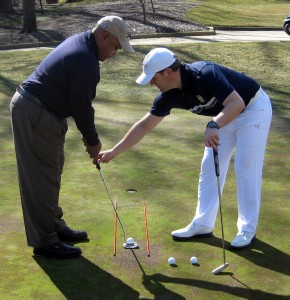When I meet a student for the first time, I usually will ask a lot of questions to find out as much as I can about them and their golf game. It’s also a way to have a quick conversation in hopes of making them feel comfortable and relaxed. Many students that I have seen this year have come to me for their very first golf lesson, and they have a great deal of anxiety associated with hitting a golf ball in front of a golf professional. So my goal in asking questions is to warm up to them just as much as it is to find out some basic information. But in asking these questions, it’s really been surprising to me how many students don’t have a plan in place or a goal in mind when coming to see me for a lesson.
A golf lesson is no different to some degree than going to the doctor. You make an appointment with a qualified professional, you go there (hopefully on time) for guidance and consultation, and you almost always go with a plan in place as to what you need diagnosed. Same with getting your car fixed, going to the dentist, etc. But why not take the same approach in a golf lesson? Not having a plan in place or at least some thoughts about your game and what you want to work on, or a goal that you would like to achieve long term, is just holding the process back. It makes the golf professional take longer to diagnose what is the major need in you game, when he/she could go right to the heart of the matter with a little guidance from the student.
When I ask the question, “What do you want to work on the most?”, I usually get the answer, “Everything.” Unfortunately, a one hour lesson is too short to work on “everything”; as a teacher I want you to come back and see me for more lessons so that I CAN try and fix “everything” (or close to it). But I will help you achieve better results by knowing what the first step in our process needs to be to help you improve.
So a couple of suggestions to help with this information for your next lesson. First, take some stats down on your game. Keep track of the fairways hit, greens hit in regulation, putts per green, up and downs from inside 100 yards, etc. This was recently hammered home to me by Steve Bosdosh,PGA, Golf Magazine Top 100 teacher, at a recent teaching summit. He has his students keep stats that are relevant for THEM; so if you are a high handicapper keep track of how many balls you lose, how many putts you had, or some other stat that is basic but can be used to later show improvement. I thought this was a great way to get things in perspective and understand your weaknesses.
Also, be honest. Self assessment is often a difficult thing for people, as it is difficult to address weaknesses. Let’s face it, no one likes to admit they aren’t good at something! But the sooner you can understand that it is not a about who you are and just about the fact that GOLF IS HARD, the sooner you can get better at the game. As an example, many people will tell me that they are good putters, and this usually make me go right into asking them some pointed questions about it. When you dig deeper, you usually find that they may have a couple of one-putt bogeys, which makes them feel good because they putted only once. Then throw in a couple of three-putts, and they aren’t as good as they thought they were at this part of the game.
Take some time to keep some stats when you play, and if you aren’t playing much but are going to the range, then pick targets and hit balls at them, keeping track of how many times you “hit the green” versus “missed the green.” Be honest! Then find a “fairway” on the range and play some holes from your favorite course in your head and get a feel for how well you are doing. Then write these stats down, along with your long-term goals for improvement. If it is just to enjoy the game more and isn’t score oriented – that’s fine too – but make sure you are clear and concise with your golf professional the next time you go in for a lesson. Results will follow a lot faster.




